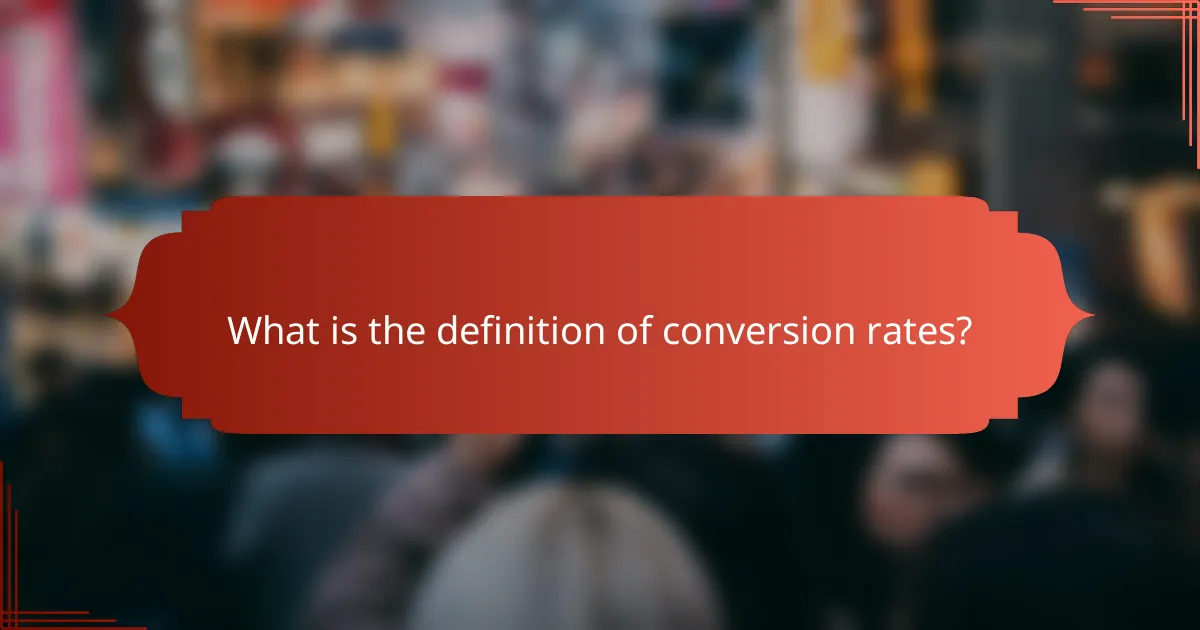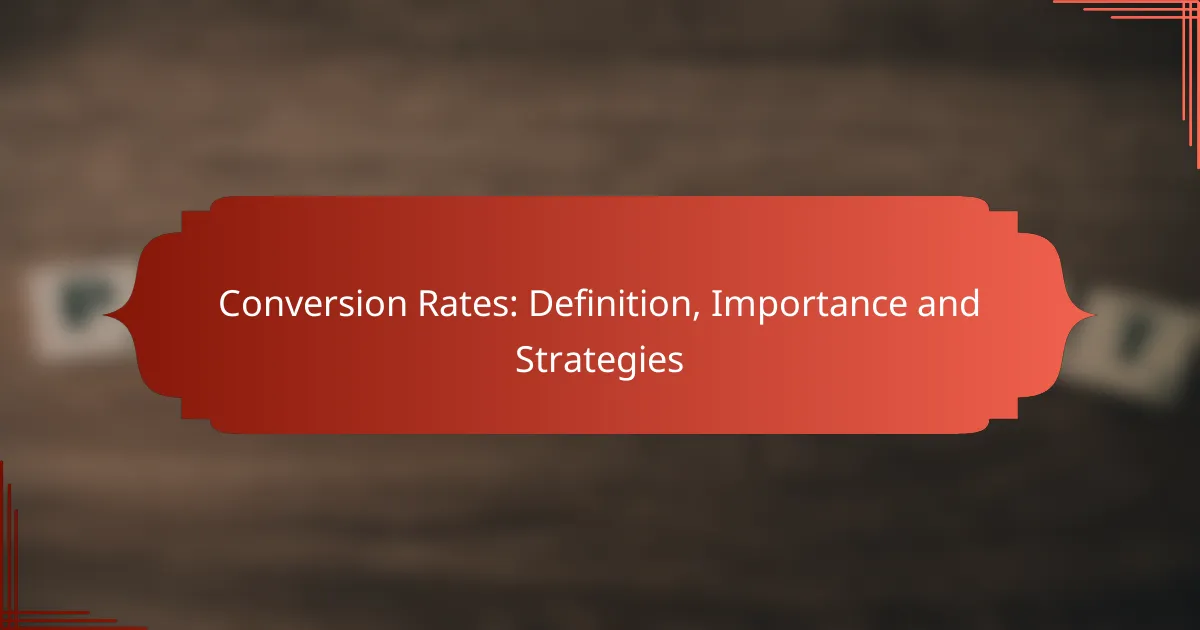Conversion rates are a vital metric for businesses, measuring the percentage of website visitors who complete desired actions like making a purchase or signing up for a newsletter. Understanding and improving these rates is essential for evaluating marketing effectiveness and enhancing user experience. By implementing targeted strategies such as A/B testing and optimizing landing pages, businesses can significantly boost their conversion rates, leading to increased profitability and growth.

How can businesses improve conversion rates in the UK?
Businesses in the UK can improve conversion rates by implementing targeted strategies that enhance user experience and engagement. Focusing on A/B testing, optimizing landing pages, and leveraging customer feedback are essential steps to increase the likelihood of visitors completing desired actions.
Utilize A/B testing
A/B testing involves comparing two versions of a webpage to determine which one performs better in terms of conversion rates. By changing elements like headlines, images, or call-to-action buttons, businesses can gather data on user preferences and behaviors.
To effectively conduct A/B tests, ensure that you have a clear hypothesis and sufficient traffic to achieve statistically significant results. Aim for a testing period of at least a few weeks to account for fluctuations in user behavior.
Optimize landing pages
Landing pages should be designed with a clear focus on conversion goals. This includes having a compelling headline, concise content, and a strong call-to-action that guides users toward the next step.
Consider using visuals that support the message and ensure that the page loads quickly, ideally within a few seconds. Regularly review analytics to identify areas for improvement, such as high bounce rates or low engagement times.
Implement customer feedback
Gathering customer feedback can provide valuable insights into user experience and areas needing improvement. Use surveys, feedback forms, or direct interviews to understand customer pain points and preferences.
Act on the feedback by making necessary adjustments to your website or service offerings. This not only helps improve conversion rates but also builds customer trust and loyalty.
Enhance call-to-action visibility
Call-to-action (CTA) buttons should be prominent and easily accessible on your website. Use contrasting colors and clear, action-oriented text to draw attention to these buttons.
Position CTAs strategically throughout your content, especially at the beginning and end of pages, to maximize visibility. Testing different placements can help identify the most effective locations for conversions.
Leverage social proof
Social proof, such as customer reviews, testimonials, and case studies, can significantly influence potential buyers. Displaying positive feedback prominently on your site can enhance credibility and encourage conversions.
Consider integrating user-generated content, such as photos or videos from satisfied customers, to create a more relatable and trustworthy environment. Highlighting well-known brands or partnerships can also serve as effective social proof.

What is the definition of conversion rates?
Conversion rates measure the percentage of visitors who complete a desired action on a website, such as making a purchase or signing up for a newsletter. This metric is crucial for evaluating the effectiveness of online marketing efforts and optimizing user experience.
Percentage of visitors completing desired actions
The conversion rate is calculated by dividing the number of successful conversions by the total number of visitors, then multiplying by 100 to get a percentage. For example, if 1000 visitors come to a site and 50 make a purchase, the conversion rate is 5%. Understanding this percentage helps businesses identify how well they are engaging their audience.
Monitoring conversion rates allows businesses to assess the effectiveness of different marketing channels. A higher conversion rate often indicates that the marketing strategy resonates well with the target audience, while a lower rate may signal the need for adjustments in messaging or user experience.
Key performance indicator for marketing effectiveness
Conversion rates serve as a key performance indicator (KPI) for marketing effectiveness, providing insights into how well campaigns are performing. A strong conversion rate suggests that the marketing efforts are successfully driving the right traffic to the site and encouraging desired actions.
To improve conversion rates, businesses should focus on optimizing landing pages, enhancing call-to-action elements, and ensuring a seamless user experience. Regularly testing different approaches, such as A/B testing, can help identify the most effective strategies for increasing conversions.

Why are conversion rates important for UK businesses?
Conversion rates are crucial for UK businesses as they directly influence profitability and growth. A higher conversion rate indicates that a larger percentage of visitors are taking desired actions, such as making purchases or signing up for newsletters, which ultimately boosts revenue.
Direct impact on revenue generation
Conversion rates significantly affect revenue generation by determining how effectively a business turns potential customers into paying ones. For instance, if an e-commerce site has a conversion rate of 2%, it means that out of every 100 visitors, only 2 make a purchase. Increasing this rate even slightly can lead to substantial revenue increases.
Businesses can enhance conversion rates by optimizing their websites, improving user experience, and offering competitive pricing. Simple changes, like clearer calls to action or streamlined checkout processes, can lead to noticeable improvements in sales.
Indicates marketing campaign success
Conversion rates serve as a key performance indicator for assessing the success of marketing campaigns. A high conversion rate suggests that the campaign effectively resonates with the target audience, while a low rate may indicate the need for adjustments in messaging or targeting.
For example, if a social media advertisement drives traffic to a website but results in low conversions, it may be necessary to refine the ad content or the landing page to better align with customer expectations. Regularly tracking conversion rates can help businesses pivot their strategies quickly and effectively.
Helps in customer retention strategies
Understanding conversion rates can also inform customer retention strategies. A business that knows its conversion rates can identify which customers are likely to return and which are at risk of churning. By focusing on improving these rates, companies can implement targeted retention efforts.
For instance, offering personalized discounts to repeat customers or creating loyalty programs can enhance customer satisfaction and increase the likelihood of repeat purchases. Monitoring conversion rates helps businesses refine these strategies to maximize customer loyalty and lifetime value.

What strategies can enhance conversion rates?
To enhance conversion rates, businesses can implement targeted strategies that focus on improving user engagement and simplifying the purchasing process. Key methods include personalizing user experiences, utilizing retargeting ads, and streamlining the checkout process.
Personalization of user experience
Personalizing the user experience involves tailoring content and offers to meet individual preferences and behaviors. This can be achieved through data analysis, which helps identify user interests and past interactions.
For example, e-commerce sites can recommend products based on previous purchases or browsing history. Implementing personalization can lead to higher engagement and increased conversion rates, as users feel more connected to the brand.
Utilization of retargeting ads
Retargeting ads are a powerful strategy to re-engage users who have previously visited a website but did not convert. By displaying targeted ads across various platforms, businesses can remind potential customers of products they showed interest in.
Effective retargeting can increase conversion rates significantly, as it keeps the brand top-of-mind. It’s essential to balance frequency to avoid ad fatigue, which can lead to negative perceptions of the brand.
Streamlining the checkout process
A streamlined checkout process minimizes friction and reduces cart abandonment rates. Key elements include simplifying forms, offering multiple payment options, and providing clear progress indicators during the checkout.
For instance, allowing guest checkouts can enhance user convenience, as many customers prefer not to create an account. Regularly testing the checkout flow for usability can help identify and eliminate potential obstacles that deter conversions.

What metrics should be tracked for conversion rate optimization?
To optimize conversion rates effectively, it is essential to track metrics that provide insights into user behavior and the effectiveness of marketing strategies. Key metrics include click-through rates, bounce rates, and customer acquisition costs, each offering valuable data to enhance conversion strategies.
Click-through rates
Click-through rate (CTR) measures the percentage of users who click on a specific link compared to the total number of users who view a page or an ad. A higher CTR indicates that your content is engaging and relevant to your audience. Aim for a CTR of around 2-5% for email campaigns and 1-3% for display ads, depending on the industry.
To improve CTR, focus on crafting compelling headlines and calls to action. A/B testing different versions of your content can help identify which elements resonate best with your audience.
Bounce rates
Bounce rate refers to the percentage of visitors who leave your site after viewing only one page. A high bounce rate may indicate that your landing page is not relevant or engaging enough. Generally, a bounce rate below 40% is considered good, while rates above 70% may require attention.
To reduce bounce rates, ensure that your landing pages load quickly and provide valuable content that meets user expectations. Consider using engaging visuals and clear navigation to keep visitors exploring your site.
Customer acquisition cost
Customer acquisition cost (CAC) is the total cost of acquiring a new customer, including marketing expenses and sales efforts. Understanding CAC is crucial for evaluating the profitability of your marketing strategies. A lower CAC indicates more efficient marketing, while a higher CAC may suggest the need for optimization.
To manage CAC effectively, analyze your marketing channels and focus on those that yield the highest return on investment. Regularly review and adjust your strategies to ensure that you are attracting customers cost-effectively.
